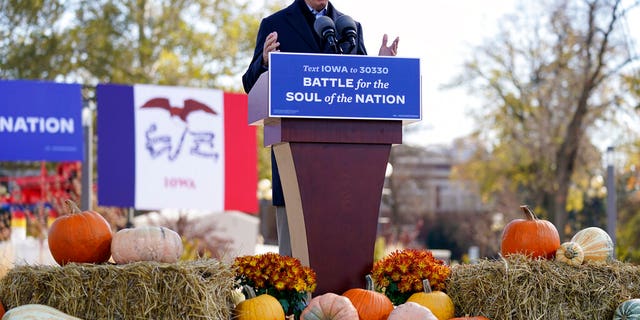With three days to go until Election Day on Nov. 3, President Trump faces challenging poll numbers, but the president predicts he’ll pull out a victory
“We
are going to win four more years in the White House,” President Trump
told supporters at a rally in Tampa, Fla., on Thursday. “We’re winning.
We are winning again.”
The numbers currently don’t appear to add up as well for the president. A new Fox News poll conducted
Tuesday through Thursday, and released on Friday evening, showed
Democratic presidential nominee Joe Biden leading the president 52% to
44% among likely voters nationwide.
And an average of the Fox News
poll and other latest national surveys indicate Trump trailing Biden by
roughly 8 points. That’s a bigger deficit than he faced against 2016
Democratic nominee Hillary Clinton at this time in the presidential election four years ago.
At
the time, with just days ahead of the 2016 election, Clinton’s sizeable
lead from just a couple of weeks earlier had diminished to just a
1.5-point edge over Trump. On the eve of the election, Clinton held a
3.2-point advantage over Trump, according to an average compiled by Real
Clear Politics. Clinton ended up winning the national popular vote by 2
points.
But it’s the states and their electoral votes that decide
who wins the White House -- and thanks to victories in six key
battleground states that he flipped from blue to red, Trump trounced
Clinton in the Electoral College vote.
Fast-forward four years and
Biden has the slight edge in many of the key battlegrounds, according
to an average of the most recent public opinion surveys.
But Trump still has an avenue to victory.
While
the national polls were relatively close to the mark in 2016, surveys
in many of the key battlegrounds appeared to under-sample Trump
supporters, and Trump narrowly won three states -- Pennsylvania,
Michigan and Wisconsin -- where an average of the final polls indicated
Clinton on top. And he outperformed the polls in a couple of other
battlegrounds.
The question now is whether the current surveys are
counting the broad swath of voters they missed four years ago. And
separate from the polls, Republican voter registration is up in several
key states, including Florida, North Carolina and Pennsylvania.
The
president and the Trump campaign have repeatedly discounted public
opinion surveys and say that their internal numbers paint a different
picture.
Biden,
campaigning Monday in Pennsylvania, emphasized that he’s “not
overconfident about anything. I want to make sure that we turn out every
vote possible.”
Biden
-- who was born and spent his first decade in Scranton, Pa. -- said
that “with the grace of God and goodwill, I’m going to win Pennsylvania.
It matters a great deal to me, personally and politically.”
“I
think we’re going to win Michigan, I think we’re going to win Wisconsin,
I think we’re going to win Minnesota. I think we have a fighting chance
in Ohio, I think we have fighting chance in North Carolina, a fighting
chance in Georgia, a fighting chance in Iowa,” he added.
Here's a look at the 12 states that will likely decide who wins the presidential election
Florida
With 29 electoral votes up for grabs, Florida is the largest of the traditional battlegrounds.
Twenty
years ago, it was the state that decided the presidential election
between then-Texas Gov. George W. Bush and Vice President Al Gore.
President Bush won the state by five points in his 2004 reelection.
President
Barack Obama carried the state by razor-thin margins in both 2008 and
2012. But four years ago, Trump narrowly edged out 2016 Democratic
nominee Hillary Clinton by 1.2 points to flip the state from blue to
red.
An average of the most recent polling in the state shows Biden holding a slight lower-single-digit edge over the president.
Democratic presidential candidate former Vice President Joe Biden
speaks at a drive-in rally at the Florida State Fairgrounds, Thursday,
Oct. 29, 2020, in Tampa, Fla. (AP Photo/Andrew Harnik)
Biden and Trump held dueling rallies in the Sunshine
State on Thursday. Many political analysts and pundits say that
Florida’s a must-win state for the president.
Biden told his supporters in the state that “you hold the key. If Florida goes blue, it’s over, it’s over.”
Arizona
Arizona has long backed Republicans in presidential elections.
President
Bill Clinton in 1996 was the only Democratic candidate to win the state
since 1952. But Trump carried the state by just 3 points four years
ago. An average of the most recent public opinion polls in Arizona
indicates Biden and the president basically tied in the battle for the
state’s 11 electoral votes.
President Donald Trump arrives for a campaign rally at Phoenix
Goodyear Airport, Wednesday, Oct. 28, 2020, in Goodyear, Ariz. (AP
Photo/Evan Vucci)
As with Florida, the president’s handling of the
coronavirus pandemic appears to be doing him no favors with the state’s
crucial senior voters.
North Carolina
North Carolina’s seeing plenty of candidate traffic, and its airwaves are being flooded with ads.
Then-Democratic
presidential nominee Sen. Barack Obama carried the state in 2008 by a
razor-thin margin over Sen. John McCain. Four years later, GOP nominee
Mitt Romney won the state’s 15 electoral votes by roughly 2 percentage
points over President Obama.
Polls on the eve of the 2016
presidential election indicated Trump with a 0.8% edge over Democratic
nominee Hillary Clinton. Trump ended up winning the state by 3.6 points.
Fast forward four years and Biden currently has a razor-thin edge over the president in an average of the most recent polls.
Pennsylvania
Four years ago Trump became the first Republican presidential nominee to win Pennsylvania
since George H.W. Bush in 1988. Trump carried the state by less than 1
percent over Clinton, to capture Pennsylvania’s 20 electoral votes.
But
the Biden campaign has heavily concentrated on Pennsylvania, which is
the former vice president’s native state. And during his nearly four
decades in the Senate representing Delaware, Biden was known as
Pennsylvania’s third senator.
An average of the most recent public
opinion polls in Pennsylvania indicates Biden with a mid-single-digit
advantage over the president.
Trump returns to the Keystone State
on Saturday and Monday, with Biden stopping there on Sunday and the
former vice president, running mate Sen. Kamala Harris, and their
spouses fanning out across the state all day on the eve of the election.
Wisconsin
Like Pennsylvania, Trump in 2016 broke the Democrats' quarter-century winning streak in Wisconsin with a narrow victory over Clinton.
But
as is the case in Pennsylvania, Trump is underperforming with key
constituencies, including suburban voters. Also working against the
president – the coronavirus – which has hit Wisconsin particularly hard.
President Donald Trump arrives to speak at a campaign rally at
Green Bay Austin Straubel International Airport, Friday, Oct. 30, 2020,
in Green Bay, Wis. (AP Photo/Alex Brandon)
An average of the most recent public opinion polls in
Wisconsin indicates Biden with a mid-single-digit lead over the
president in the battle for the state’s 10 electoral votes.
Ohio
Ohio has
long played a crucial role in presidential elections. It was the state
that famously put President George W. Bush over the top in 2004, as he
won a second term in the White House.
Obama narrowly carried the
state in 2008 and 2012. Four years ago, it appeared it would be another
close contest, with an average of the polls on the eve of the election
indicating Trump narrowly ahead of Clinton. But Trump ended up swamping
Clinton by eight points, flipping the state from blue to red and winning
Ohio’s 18 electoral votes.
Trump’s margin of victory was the
largest by any presidential candidate in nearly three decades. Fast
forward four years and Ohio – at the beginning of this presidential
cycle -- wasn’t expected to be a battleground.
But the race has
tightened and both campaigns are heavily investing in the Buckeye State.
An average of the latest polls indicates the race is basically all tied
up in Ohio.
Iowa
Obama carried Iowa by
six points in the 2012 election, but Trump flipped the Hawkeye State
four years ago, topping Clinton by nine points, even though the final
surveys suggested a much closer margin.
As with Ohio, it wasn't on the battleground radar a year ago.
Democratic presidential candidate former Vice President Joe Biden
speaks at a rally at the Iowa State Fairgrounds in Des Moines, Iowa,
Friday, Oct. 30, 2020. Biden is holding rallies today in Des Moines,
Iowa, Saint Paul, Minn., and Milwaukee, Wis. (AP Photo/Andrew Harnik)
But Iowa's very much in the spotlight now, with an
average of the latest public opinion surveys in the state indicating
Biden with a razor-thin edge over the present.
Georgia
Southerner Bill Clinton in 1992 was the last Democrat to carry Georgia in a presidential election.
Long
a red state, Georgia tightened in the 2016 election when Trump captured
the state’s 16 electoral votes by just 5 points. The president,
apparently playing some defense, recently campaigned in the state and
returns on Sunday. Biden made his first general election trip to the
state this week.
An average of the last public opinion surveys in Georgia suggests Biden with a razor-thin edge over Trump.
Michigan
Democrats carried Michigan for a quarter-century in presidential elections until Trump won the state by a tight margin four years ago.
But
the president's support among White working-class voters doesn't appear
to be matching the 2016 levels and Black turnout, which was down four
years ago, appears to be re-energized.
An average of the most
recent public opinion polls in Michigan indicates Biden with an
upper-single-digit lead over the president in the battle for the state's
16 electoral votes.
Biden teams up in-person with his one-time boss, former President Obama, for two stops in Michigan on Saturday.
On
Election Eve in 2016, the president’s last rally was past midnight in
Grand Rapids, Michigan. In what appears to be a hope to repeat history,
the Trump campaign says that the president’s last stop on Election 2020
will once again be Grand Rapids, Michigan.
Nevada
President George W. Bush in 2004 was the last GOP standard-bearer to win Nevada.
But Clinton narrowly edged Trump by just 2 points four years ago and
Trump’s been eyeing to flip the Silver State from blue to red.
Both
campaigns have invested time, money and resources in the state in the
battle for its 6 electoral votes. An average of the latest polls
indicates Biden holding a mid-single-digit advantage.
Minnesota
President Richard Nixon was the last Republican to win the state – during his 1972 landslide re-election.
But four years ago Trump narrowly lost Minnesota and
its 10 electoral votes to Clinton, and for over a year the president
and his re-election campaign have been eyeing the state in hopes of
breaking the losing streak and flipping it from blue to red.
An
average of the latest public opinion polls in the state indicate the
former vice president with a mid-single-digit advantage over Trump, but
the surveys suggest that Trump’s gained ground over the past month.
The presidential nominees held dueling rallies in Minnesota on Friday.
Texas
It’s been nearly half a century since a Democrat won Texas in a presidential election — you’ve got to go back to then-former Georgia Gov. Jimmy Carter in 1976.
But the longtime ruby-red state has become more competitive in recent years.
Trump won Texas and its whopping 38 electoral votes by nine points in the 2016 election, down from Republican nominee Mitt Romney’s 16-point win over President Obama in the state in 2012.
The
Cook Report, a leading nonpartisan political handicapper, this week
changed its rating of the state from Lean Republican to Toss Up. The
most recent polls indicate Trump with a slight edge over Biden that's
within the margin of error.
Democratic vice presidential nominee Sen. Kamala Harris made three stops in the Lone Star State on Friday.
























